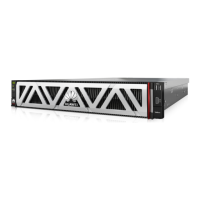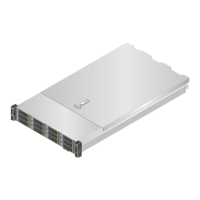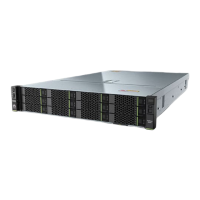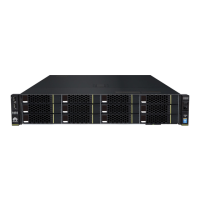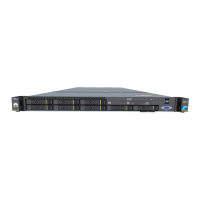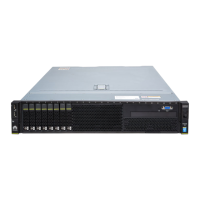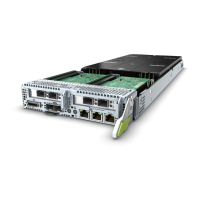Do you have a question about the Huawei TaiShan 2280 V2 and is the answer not in the manual?
Describes the document's content and scope, including functions and installation.
Identifies the target readers of this user guide, such as engineers and administrators.
Explains the meaning of symbols used throughout the manual for warnings and notices.
Details the physical components located on the server's front panel, like drives and ports.
Explains the function of indicators and buttons on the server's front for status and control.
Describes the physical components and ports on the server's rear panel.
Explains the status indicators located on the server's rear panel.
Illustrates the physical layout and numbering of DIMM slots on the motherboard.
Explains how drive slots are numbered and the meaning of their indicators.
Describes the indicators for SAS/SATA drives, indicating their status.
Describes the indicators for NVMe SSDs, indicating their status.
Details the different riser cards and their associated PCIe slot configurations.
Information regarding the server's fan modules and cooling system operation.
Overview of the server's internal physical layout and key components.
Step-by-step instructions for powering on the server using various methods.
Procedures for safely shutting down the server to standby or off state.
Instructions for safely removing the server from the rack and its guide rails.
Instructions for opening the server by removing its top cover.
Instructions for closing the server by reinstalling its top cover.
Procedures for removing a server fan module for replacement or maintenance.
Procedures for installing a server fan module correctly.
Instructions for removing riser card trays from the server.
Instructions for installing riser card trays into the server.
Guidelines for server installation environment, including space, temp, and humidity.
Details space and airflow needs for proper server operation and cooling.
Specifies acceptable temperature and humidity limits for server operation.
Lists requirements for server installation cabinets, including dimensions and standards.
Steps for safely unpacking the server chassis from its packaging.
Procedures for mounting the server into a rack using guide rails.
Specific steps for installing with L-shaped guide rails.
Specific steps for installing with adjustable guide rails.
Guidelines for connecting various external cables to the server ports.
Steps for the initial setup and configuration of the server.
Lists default IP addresses, usernames, and passwords for initial server configuration.
Detailed steps to access the server's management interface via web browser.
Instructions for changing default user passwords for security purposes.
Steps for configuring the server's BIOS settings and options.
Safety and general precautions before installing optional server parts.
Information and steps for removing and installing the optional front bezel.
Steps to remove a drive from the server without powering it off.
Steps to install a new drive into the server, including hot-swap procedures.
Steps to install an AC Power Supply Unit into the server.
Steps to install a PCIe card onto a riser card for expansion.
Steps to install a screw-in RAID controller card onto the mainboard.
Information on DIMM compatibility, ranks, identification, and installation.
Rules for ensuring DIMM compatibility and proper configuration for optimal performance.
Step-by-step procedure for correctly installing a DIMM into a memory slot.
Steps to install a FlexIO module into the server for additional connectivity.
Procedures for installing rear drive assemblies into the server chassis.
Details internal cabling connections for a specific server drive configuration.
Details cabling for front drive backplanes, including power and signal connections.
Details cabling connections for NVMe SSD adapters.
Details internal cabling connections for a specific server configuration.
Information about the system's BIOS, its functions, and configuration.
Steps to remove the system's CMOS battery for maintenance or replacement.
Steps to install a new system's CMOS battery correctly.
Information regarding server maintenance procedures and warranty coverage.
General safety guidelines and precautions for server operation and handling.
Precautions and procedures to prevent ESD damage to sensitive components.
Detailed technical specifications of the server hardware, including processor and memory.
Specifies operating environment requirements like temperature, humidity, and noise levels.
Covers physical dimensions, weight, and rack installation requirements.
Details the specifications for the server's Power Supply Units, including power and voltage.
How to access the server's remote console for management and monitoring.
Steps for accessing the iBMC via Command Line Interface for server management.
Instructions for using the Independent Remote Console for server access.
Using PuTTY for serial port connection to the server for management.
Using PuTTY for network port connection to the server for management.
Information on obtaining technical assistance and accessing support resources and documentation.
Diagrams and descriptions of the server's logical architecture and interconnections.
Definitions of technical terms and acronyms used in the manual.
A list of common acronyms and abbreviations with their meanings.
Describes the document's content and scope, including functions and installation.
Identifies the target readers of this user guide, such as engineers and administrators.
Explains the meaning of symbols used throughout the manual for warnings and notices.
Details the physical components located on the server's front panel, like drives and ports.
Explains the function of indicators and buttons on the server's front for status and control.
Describes the physical components and ports on the server's rear panel.
Explains the status indicators located on the server's rear panel.
Illustrates the physical layout and numbering of DIMM slots on the motherboard.
Explains how drive slots are numbered and the meaning of their indicators.
Describes the indicators for SAS/SATA drives, indicating their status.
Describes the indicators for NVMe SSDs, indicating their status.
Details the different riser cards and their associated PCIe slot configurations.
Information regarding the server's fan modules and cooling system operation.
Overview of the server's internal physical layout and key components.
Step-by-step instructions for powering on the server using various methods.
Procedures for safely shutting down the server to standby or off state.
Instructions for safely removing the server from the rack and its guide rails.
Instructions for opening the server by removing its top cover.
Instructions for closing the server by reinstalling its top cover.
Procedures for removing a server fan module for replacement or maintenance.
Procedures for installing a server fan module correctly.
Instructions for removing riser card trays from the server.
Instructions for installing riser card trays into the server.
Guidelines for server installation environment, including space, temp, and humidity.
Details space and airflow needs for proper server operation and cooling.
Specifies acceptable temperature and humidity limits for server operation.
Lists requirements for server installation cabinets, including dimensions and standards.
Steps for safely unpacking the server chassis from its packaging.
Procedures for mounting the server into a rack using guide rails.
Specific steps for installing with L-shaped guide rails.
Specific steps for installing with adjustable guide rails.
Guidelines for connecting various external cables to the server ports.
Steps for the initial setup and configuration of the server.
Lists default IP addresses, usernames, and passwords for initial server configuration.
Detailed steps to access the server's management interface via web browser.
Instructions for changing default user passwords for security purposes.
Steps for configuring the server's BIOS settings and options.
Safety and general precautions before installing optional server parts.
Information and steps for removing and installing the optional front bezel.
Steps to remove a drive from the server without powering it off.
Steps to install a new drive into the server, including hot-swap procedures.
Steps to install an AC Power Supply Unit into the server.
Steps to install a PCIe card onto a riser card for expansion.
Steps to install a screw-in RAID controller card onto the mainboard.
Information on DIMM compatibility, ranks, identification, and installation.
Rules for ensuring DIMM compatibility and proper configuration for optimal performance.
Step-by-step procedure for correctly installing a DIMM into a memory slot.
Steps to install a FlexIO module into the server for additional connectivity.
Procedures for installing rear drive assemblies into the server chassis.
Details internal cabling connections for a specific server drive configuration.
Details cabling for front drive backplanes, including power and signal connections.
Details cabling connections for NVMe SSD adapters.
Details internal cabling connections for a specific server configuration.
Information about the system's BIOS, its functions, and configuration.
Steps to remove the system's CMOS battery for maintenance or replacement.
Steps to install a new system's CMOS battery correctly.
Information regarding server maintenance procedures and warranty coverage.
General safety guidelines and precautions for server operation and handling.
Precautions and procedures to prevent ESD damage to sensitive components.
Detailed technical specifications of the server hardware, including processor and memory.
Specifies operating environment requirements like temperature, humidity, and noise levels.
Covers physical dimensions, weight, and rack installation requirements.
Details the specifications for the server's Power Supply Units, including power and voltage.
How to access the server's remote console for management and monitoring.
Steps for accessing the iBMC via Command Line Interface for server management.
Instructions for using the Independent Remote Console for server access.
Using PuTTY for serial port connection to the server for management.
Using PuTTY for network port connection to the server for management.
Information on obtaining technical assistance and accessing support resources and documentation.
Diagrams and descriptions of the server's logical architecture and interconnections.
Definitions of technical terms and acronyms used in the manual.
A list of common acronyms and abbreviations with their meanings.
